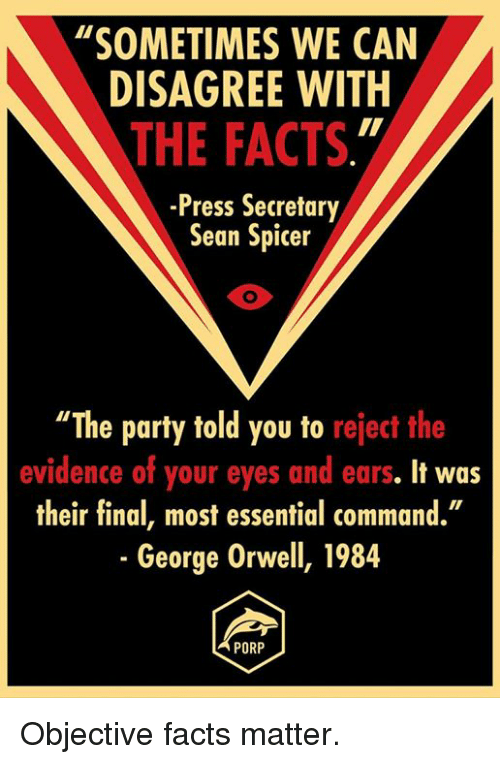Fake News Isn’t the Problem, Relativism Is
When the soon-to-be-president Trump called a CNN reporter ‘fake news’ to his face, it was both entertaining and ironic. First of all, it was great theater seeing such an esteemed agency being called out in such a public forum. But, if anyone is a peddler of fake news, it is Trump.
Fake news has become something of a boogeyman man of late. Since Trump’s surprising election, politicians and pundits from both sides of the debate have pointed to fake news as a major culprit in the debacle.
But so-called fake news is not limited to news agencies broadcasting dubious partisan views—that is just the most prominent example, so everyone, including the future president, is harping on it. Looking closer, we see that fake news actually stems from a more fundamental crisis of philosophy that has swept through our culture in the last decades: The belief that truth is relative and all one needs to do to make something true is to say it. That philosophy is what fake news is all about, and the Donald might be its most reliable adherent.
The Post-Truth Era
Ever since the election, pundits and sore loser Hillary supporters have been up in arms. The idea is that new media organizations spread articles, clips, and memes full of falsehoods and fallacies that persuade vast contingents of people to believe some blatantly wrong things. Because it’s all framed as real news, people consume it, believe it, and share it, thus spreading the fakery to all corners of society, sometimes outpacing and overshadowing what might be called ‘real news’.
 As a result, fake news has been blamed for all kinds of wild widespread beliefs and many suggest that fake news is the cause of criminal or otherwise regrettable behavior. Not a few pundits blamed fake news for the surprise 2016 presidential election. From polls that claimed Clinton had a safe lead going into the election to bizarre stories that said Pope Francis endorsed Trump, fake news seemed to guide the election throughout. Post-election, critics have pounced on White House representatives KellyAnne Conway for suggesting that they could use “alternative facts” and Sean Spicer for saying that “sometimes we disagree with the facts”.
As a result, fake news has been blamed for all kinds of wild widespread beliefs and many suggest that fake news is the cause of criminal or otherwise regrettable behavior. Not a few pundits blamed fake news for the surprise 2016 presidential election. From polls that claimed Clinton had a safe lead going into the election to bizarre stories that said Pope Francis endorsed Trump, fake news seemed to guide the election throughout. Post-election, critics have pounced on White House representatives KellyAnne Conway for suggesting that they could use “alternative facts” and Sean Spicer for saying that “sometimes we disagree with the facts”.
It has gotten to the point that critics have called this the ‘Post-Truth Era’.
In response, the outcry has been swift and fierce. The pejorative ‘fake news’ has been slung around as a way to discredit questionable agencies, an effort that our bombastic president has eagerly joined in on. Meanwhile, Facebook execs pledged to cut down on the fake news sites that disseminate through their social network. And many reputable sources have released nifty how-to guides for determining the difference between real and fake news.
Of course, none of this seems to be making an impact. After two months of disclaiming fake news and vowing to stick to the truth, we see the same fallacious arguments and dubious sources being flung about as if nothing has changed.
A recent incident is telling: On the day of the inauguration, the IT outlet Techcrunch ran a story on how to mitigate fake news, but the very same day it also ran a widely shared article on how the LGBT rights page had disappeared from the White House site, insinuating that the new Trump administration had immediately begun a campaign to deprive citizens of their rights.
Now, anyone with a basic understanding of politics knows that, during every inauguration, the government removes the previous administration’s policy information from the White House site. The page that Techcrunch called the ‘LGBT rights page’ was actually just an article championing Obama’s support of the LGBT community and featured a picture of the former president signing a law with a bunch of gay people around him. There would be no reason for Trump to keep the page up no matter what the custom was. And, yet, Techcrunch saw it fit to rage about how the Trump era was already hindering progress that was so diligently fought for during the last eight years. This was by all accounts a fake news article. And it permeated the ether with the best of them.
It would seem that Techcrunch, like pretty much every other media outlet around these days, just cannot put down the fake news habit. Even when they acknowledge the problem and dedicate time and effort to stopping it, they continue to disseminate it. And, all the while, falsehoods and fallacies continue to swarm around unhindered.
One wonders whether those trying to put an end to fake news really know what it is they’re supposed to be fighting. The caricature painted is of a group of unkempt political hacks in some basement cooking up the most malicious plot to sway the public mind. This is the mentality that has led to the conspiracy theory that Russia hacked the election.
When we look into it, we find that the reality is far from it. Sometimes it is just careless speculation that gives birth to the fake news; sometimes it is earnest good intention that leads us down the wrong path. In any case, it cannot be assumed that it is some vicious Russian hacker is guilty—the forces that have led us to this point are pervasive, and all sides of a given argument are affected. As the inimitable Pogo said, “We have seen the enemy and he is us.”
And so it will be constructive to pick apart this strange new phenomenon in hopes of better understanding it and ultimately combating it. What is fake news? How is it so successful? And why is it so difficult to eradicate? As we analyze, we find that it’s not so strange and new after all.
Fake News Rookery
Fake news is not news. It has been around at least since Mark Antony and Caesar Augustus fought a disinformation campaign against each other for the Empire. What’s changed is the ability for fake news to spread and the willingness of its audience to believe. As we can see, several cultural influences have culminated in recent years that have made this way of lying more effective and at the same time more irresistible.
Technical Expertise Has Boosted Credibility of Junk.
We have always relied on the quality of a given presentation to derive its credibility. The more sophisticated the technology, the more infrastructure, and the greater the polish used to disseminate the information, the more trustworthy it is thought to be. This is the principle behind the production of elaborate coins or bills to fight counterfeiting—the more embellished the money is, the harder it is to produce, and the harder it is to counterfeit. Check out the new one-hundred-dollar bill, and you’ll see some pretty amazing security features employed for this very purpose.
News production has relied on this very principle. Regard the longstanding respect that the printed word demanded since the invention of the printing press; regard the kind of reverence the big three news stations commanded during the heyday of broadcast television. If you were in the position to create such content, you were bound to ensure that content was trustworthy, and so audiences could rely on high quality as a way to discriminate between real and fake news.
These days, the principle is rather flipped. Any schmoe can produce a newspaper or video broadcast, and he can do so with increasing quality. What’s more, in the Internet Age, it’s the tech-savvy young upstarts that are capable of creating the most powerful media, and the stodgy old behemoths that have failed to stay relevant. New media outlets such as Now This, AJ+, RT, The Blaze, and The Young Turks put out slick videos that bear all the marks of integrity that NBC, CBS, and ABC used to monopolize, but without a modicum of the traditional quality of fact checking and reporting that their predecessors offered.
The result is a clip such as this supposed report on the 2017 March for Life by RT (Russian Times):
The anchor looks and acts like a Walter Cronkite, and the video clip backdrop and glitzy ticker at the bottom scream integrity. But his words are little more than propaganda, and the opinionated argument he makes is not defended by any amount of logic.
With this and countless other sources, it is as though the counterfeit bills are more sophisticated than the legitimate ones. We no longer have the luxury of associating technical expertise with quality content; and so have lost a powerful tool in fighting off fake news.
Divisiveness Has Stretched Credulity.
Soon after the election, it was common to hear Democrats fretting over the fact that their candidate lost despite winning the popular vote (Clinton secured almost three million more votes nationwide). Not long after that, fringe agencies on the right could be seen denying this data-driven fact with the claim that indeed Trump did win the popular vote despite what those on the Left were saying. At first, they relied on the logic that many of the counties’ votes had not been tabulated yet and projected that, with the remaining votes, Trump would end up with more. Then, when that became impossible, they started cherry-picking the vote: Trump won in a landslide in the heartland (no kidding); Trump got more votes if you discount the illegal immigrant vote (claimed by the president himself); Trump won the popular vote if you exclude California (Calexit, anyone?). But these qualifications didn’t make it into the narrative. By mid-December, NY Magazine reported that more than half of Republicans thought that Trump won the popular vote outright.
While some of these latter arguments might be based in truth, the notion that Trump won the popular vote cannot be defended. But that didn’t stop media outlets from pumping their channels full of that misinformation. Nor did it stop consumers from gobbling it up.
One might be able to understand the rationale from the ardent Republican standpoint: If our candidate lost the popular vote, our victory wouldn’t be fully legitimate. If our victory isn’t legitimate, then we aren’t vindicated. So, anything that contradicts the popular vote argument should be supported and shared no matter what bizarre logic is used in the process.
When times are divisive, people prioritize beating the other guy over truth and justice. The more divisive the times get, the greater the incentive to eschew truth and justice in order to win.
Coupled with the technical sorting algorithm of social media, the content that folks receive is fortified in what is called an ‘echo chamber’ and the incredulous becomes all the more credible. A fascinating study shows how two different Facebook users see the news in their feeds according to their supposed political affiliation: http://graphics.wsj.com/blue-feed-red-feed/
Hyper Sociality Has Compelled Exaggeration.
In the pursuit of likes, producers of content are incentivized to put out the most outrageous and far-fetched stories. This has been an issue since the invention of communication sometime before the Internet. But, with the reach of social media, we have seen a greater potential impact and, as a result, a greater reward for ‘going viral’. Folks have become overnight successes thanks to one video; fortunes can be made with the right message.

This is why we see people posting false information that seemingly has no real consequence. In 2012, a meme circulated that said that said some date in 2012, not the actual 2015, was the date that Marty went to in Back to the Future II. Why would anyone bother? The answer must be that they did it for instant clicks—it’s an interesting thought (that we’re living in a time when a popular movie was portrayed), and they couldn’t wait until the real date. So they created a fake meme, called it ‘Back to the Future Day’, and it spread like wildfire.
I once saw a meme that said there was going to be a full moon on Friday the 13th one May, when, in reality, it was just going to be Friday the 13th (the moon was in crescent phase). Why would anyone blatantly lie about something so silly? The only answer is for clicks.
In a social age, only information that is controversial, sensational, and incredible makes the rounds. The more controversial, sensational, and incredible, the better. Savvy communicators realize this and adjust their stories to spark the greatest interest. We see it in everyday interaction as people get more of a response from an exaggerated story than one that just tells the facts. I was on a plane before a cross-country flight and someone thought it was a good idea to yell “Free Liberia!” It was nothing more than a stupid joke coming from someone who didn’t realize the seriousness of his actions, but it forced the crew to deplane and all of the passengers to reroute. As they were facilitating, I heard someone calling his friend to explain he would be late. As he described the incident, he said that “Someone started screaming like a madman.” Of course, his friend was thoroughly engaged with the story and wanted more. It didn’t matter that that really didn’t happen; what mattered is that he had an engaged audience.
In a social age, we are incentivized to exaggerate, embroider, embellish, overstate, distort, and heighten for effect if we hope to be heard at all. The best find ways to do so without stretching the truth, but most don’t see the truth as a necessary restriction on a good performance. Speech coach James C. Humes even went so far as to encourage changing up facts of stories to personalize and make relevant. The idea is that there is a need for good, powerful communication, and, as long as the message is strong, details and facts can be overlooked.
Social media, with its tendency toward click-bait headlines and its users’ aversion to actually reading the articles, exaggerate the exaggeration.
Imprecision Lends to Crying Wolf.
Careless exaggeration is seen clearly in the use and abuse of metaphors. Critics of a given group or behavior might compare that group or behavior to a well vilified subject to paint their target in a bad light. Critics of porn call it a form of abuse, for example, critics of state government call taxes theft, critics of Trump call him a Nazi.
Instead of worsening the image of their target, they tend only to blur the meaning of the invectives used, thus making metaphor less effective. If everyone you disagree with is Hitler, then your audience is numbed by the time a real Hitler does come by and start doing the bad things you fear.
Recently, feminists have called the effort to defund Planned Parenthood a form of assault on women. The argument is understandable for those who take access to abortion services personally, but the fact is that assault has a very technical and terrible connotation, which does not include taking away government funds. If we exaggerate the trauma of such an action, we don’t make it worse in the eyes of our opponents, but rather make the real trauma less grievous. It is a form of the old Boy Who Cried Wolf saw—if everything is a wolf, even when it’s not, then no one will believe you when the real wolf appears.
The extreme is seen in the use of the term ‘hate speech’ to arraign anyone who disagrees with us, and the simultaneous effort to make illegal any use of such speech. It is clear from the perspective of the bystander that it is an effort to silence dissent and ultimately control thought. By turning thought into action and turning action into criminal violence, exponents of hate speech wield a tremendous amount of influence. But, if thought is violence, then what recourse do we have for actual violent acts?
Famous Quotes Need Famous Mouths.
The saying “Famous quotes need famous mouths” is attributed to writer Ralph Keyes. It would probably be shared more if it were attributed Abraham Lincoln. The truth of the saying can be seen throughout the social media and even as high as presidential speeches, as almost everything worth sharing has been attributed to the great statesman.

It’s true: Good ideas get far more reach when they are accompanied by a famous attribution. And so a message that needs to be heard, it is thought, needs to be attributed to a famous historical figure. What follows is a distorted view of history and usually a discrediting of what was really said.
 We see it in the ridiculous Steve Jobs deathbed meme. The story is that Steve Jobs put together a little speech on his deathbed that renounced wealth and material things and praised love and treating others well. It’s a nice thought, but he said nothing of the sort. First of all, Steve Jobs was never some money-grubbing capitalist. He was powerful at the head of Apple, but his salary was famously just $1. Secondly, he was so stubborn that it would be a stretch to believe that he would convert to anything, even on his deathbed. But this didn’t stop people from spreading the falsehood. The message is positive and people want to spread positive messages. And, in order to do so, they attribute it to a famous if implausible speaker and the message takes off. I once saw the story posted by an executive at a Fortune 200 company.
We see it in the ridiculous Steve Jobs deathbed meme. The story is that Steve Jobs put together a little speech on his deathbed that renounced wealth and material things and praised love and treating others well. It’s a nice thought, but he said nothing of the sort. First of all, Steve Jobs was never some money-grubbing capitalist. He was powerful at the head of Apple, but his salary was famously just $1. Secondly, he was so stubborn that it would be a stretch to believe that he would convert to anything, even on his deathbed. But this didn’t stop people from spreading the falsehood. The message is positive and people want to spread positive messages. And, in order to do so, they attribute it to a famous if implausible speaker and the message takes off. I once saw the story posted by an executive at a Fortune 200 company.
You can’t really say, “Wouldn’t it be nice if Steve Jobs had said this” or “Steve Jobs might have said this”. To make an impact, you have to make the direct attribution. Once you do, the message loses its credibility.
In 2016, a meme inspired by C.S. Lewis’ Screwtape Letters made the rounds with a message of unity. Of course, the owner didn’t say that it was inspired by Screwtape, she said that it came from the actual work. It is likely that she didn’t mean to really attribute it to the legendary tale, but it would have been cumbersome to say that it was ‘inspired by’, so that was left out and the impression was that good ol’ C.S. Lewis predicted our current age with the message.
Satire Is the New News.
In a scathing post-election report, comedian John Oliver of HBO’s Last Week Tonight, blamed Trump’s victory on what he called “fake facts”. Stringing up sites like Breitbart, Addicting Info, and Freedom Daily, Oliver showed how intentionally misleading news swayed opinion and how social media ‘echo chambers’ amplified the misinformation. What he forgot to point out is that he was part of the problem.
Oliver’s show follows in a successful line of news parodies that began with Saturday Night Live’s Weekend Update and continued with The Onion and then Comedy Central’s Daily Show and Colbert Report. The original idea was to mock the otherwise staid news media with farcical reports and interviews. Thirty years ago, no one could have mistaken those parodies for real news since real news was more respected and the fake stuff was clearly satirical.
Now, it’s not as clear cut. Traditional news media have lost credibility due to their inability to remain objective, and, meanwhile, the comedy shows appear more credible since they never had to be objective in the first place. One poll said that some 45% of self-identified liberals trusted what they saw on Jon Stewart’s Daily Show. Obama has made appearances on both The Daily Show and Colbert Report. And, Stephen Colbert has testified in character before a congressional hearing.

Oliver takes it to the next level. He maintains that he is not a journalist, but the fact is that he does everything to persuade his audience that he is: He is seated at a news anchor desk, presents well-researched material on under-reported topics, and has a fancy city skyline as a backdrop. He claims that they fact check everything on the show as if to suggest that they are above the board of fake news, and yet every argument he makes is riddled with straw men fallacies, inconsistencies, and childish insults. He protects himself with the notion that he is not supposed to be news, and yet many still trust him as such and he uses that authority to spread specious logic far and wide.
This trend in satire reflects a broader trend in humor generally toward sarcasm. As Tom Wolfe chronicles in his 2004 I Am Charlotte Simmons, sarcasm is based in the amount of hurt that is levied on the butt of the joke. The more subtle the sarcasm is, the longer it takes to get, the more hurt that is inflicted. As such, the younger masters at sarcasm have even split the genre into three categories, ‘Sarc One’, ‘Sarc Two’, and ‘Sarc Three’. Progressing from Sarc One to Three takes you from regular, fairly obvious sarcasm like “Cerise is such an in color this year” to nearly impossible to discern “I love that shirt. It’ll be perfect for job interviews, and it’ll be perfect for community service.”
The best humor these days is nearly imperceptible from straightforward communication. The Simpsons’ sharp commentary reflected this fact in a show titled ‘Homerpalooza’. As Homer’s character was making his way into view, one of the slacker youths in the audience said “Oh here comes that cannonball guy, he’s cool.” To which his friend asks, “Are you being sarcastic, dude?” And the first replies, “I don’t even know anymore.”
In the new century it is impossible to discern sarcasm from sincerity, and, as we’ve discovered, satire from journalism.
It has gotten to the point that satirical shows such as SNL’s Weekend Update and John Oliver’s Last Week Tonight have found it necessary to break away from their usually ambiguous humor to state cold facts so as to dissolve any potential confusion. When Seth Myers had a caricature of a crazed Republican on the show, he didn’t answer her outlandish claim that Obama was a Muslim from Kenya with wit or even more jokes; he was obliged to say flatly, “No, he isn’t.” These days, comedy is the victim of its own success.
Relativism Reigns.
What is most ironic about this fake news foofaraw is that the ones who are most outraged by the fact that fake news might have swayed the election (like John Oliver and his followers) are the very ones who would subscribe to the philosophical principle of relativism. They subscribe to the most acclaimed philosophers, pundits, and intellectuals of the last hundred years who have said that all truth is relative and anyone purporting to assert universal truths is wrong and probably dangerous.
As Allan Bloom explained in his landmark Closing of the American Mind, our culture has equipped us with a framework of openness from early ages, such that no one has the right to assert anything absolutely. All must be accepted and all must be embraced as equally valuable.
We see it in Freud, who argued that all reason is just rationalizing our base instincts; we see it in Deconstructionism, which claims that words cannot possibly represent meaning; we see it in the multiculturalism which asserts that no given culture is morally superior to others; we see it in Behavioral Economics which states that we are all irrational and cannot help but to hinder our own best interests; we see it in modern parenting, which is defined by what might be called ‘trophyism’, or the eagerness for parents, teachers, and coaches to reward children when they haven’t done anything notable; we see it most recently in the transgender fad in which everyone is encouraged to express him or herself anyway he or she likes even if it means transforming his or her himness or herness.
Relativism has been with us a while. It is the fruit of 13th century philosopher William of Ockham’s Nominalism which states that there can be no universals, only specifics. Ockham was a serious philosopher, and his idea was highly controversial. The upshot was clear: If there are no universal truths, then whatever one wants to be true is true. The more people that believe a certain thing, the truer it becomes. Thus, those who are most vocal, most popular, and most forceful get to determine what the truth is for the populace. Ultimately, we are led to the stance that Thrasymachus takes in Plato’s Republic: Might makes right; justice is power.
In Hamlet, Shakespeare has the prince offer up a bit of philosophy that summarizes the issue: “There is nothing good or bad, but thinking makes it so.” It is the foundation of Positivism and ultimately Nihilism because the thought that nothing has meaning is necessarily contradictory and destroys itself. As Peter Kreeft explains, “The skeptic must say that it is true that there is no truth; or it is certain that there is no certainty; or it is objectively true that truth is not objective; or I know that I cannot know; or even it is only probable that there is only probability; or there are absolutely no absolutes; or it’s a universal truth that no truth is universal.”
 As a culture, we have combated this tempting philosophy through right reason and a politico-economic system that protects freedom of thought. Throughout the 20th century, various forces have combined to break down our ability to fend off Nominalism to the extent that most live by the philosophy if not overtly champion it.
As a culture, we have combated this tempting philosophy through right reason and a politico-economic system that protects freedom of thought. Throughout the 20th century, various forces have combined to break down our ability to fend off Nominalism to the extent that most live by the philosophy if not overtly champion it.
Now, with the technology of the Internet and our hyper sociality, the barriers to Nominalism have fallen completely, and we suddenly hear warning cries from all around: ‘We have entered the Post-Truth Era—our culture is doomed!’ The warning would be taken more seriously if it weren’t being broadcast by those who so adamantly ushered us into this era.
In a classic parody, the Onion-esque religious satire site The Babylon Bee posted an ingenious article titled “Culture In Which All Truth Is Relative Suddenly Concerned About Fake News”. In a swift blow, it summarized the utter hypocrisy of the whole movement: “ ‘It’s just absolutely wrong, in my opinion,’ said the man who doesn’t believe in absolute ideals of right and wrong at all. ‘What if someone reads the information and gets like, deceived? That just seems totally wicked.’ ”
It would be funny if it weren’t absolutely true.




